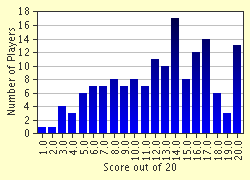Quiz Answer Key and Fun Facts
1. The city was founded in the 7th century AD by Roman refugees fleeing the earthquake of Epidaurus, town just to the southeast of Dubrovnik. What was the name originally given to the new city?
2. What does the name 'Dubrovnik' mean in Serbian and Croat (Serbo-Croatian)?
3. Who ruled Dubrovnik after the fall of Rome?
4. From 1205-1358, Dubrovnik acknowledged the suzerainty of which foreign power?
5. The city-republic afforded asylum to refugees of all nations. What famous man took refuge inside city's strong walls?
6. Ragusan land trade flourished throughout the Balkans, and Dubrovnik signed special trading charters (treaties) with neighboring countries giving it considerable merchant privileges. The most famous, The Charter of Ban Kulin of Bosnia (1189) was written in what alphabet?
7. By means of treaties and tribute, Dubrovnik enlarged its territory along the Dalmatian coast. The biggest gain was the long Peninsula of Ston (Stonski Rat) - also called Pelje?ac . From which country did Dubrovnik buy it?
8. The Republic sent ships and warriors as military aid to Spain in 1588 for what Spanish military venture?
9. For centuries Dubrovnik was able to preserve its status as an independent city-republic by skillful manoeuvring between major powers. A strategic treaty with ________ prolonged Dubrovnik's liberty during 15th and 16th centuries.
10. Dubrovnik provided military assistance and ships to both sides in what battle?
11. A great development of art and literature, from the 15th century to the 17th, earned Dubrovnik the title of "the South Slav Athens." For the first time in the history of the South Slavs, the language of the people was introduced into literature. What language was spoken in Dubrovnik?
12. The most outstanding achievement of Dubrovnik Renaissance literature, that gave the city name of "South Slav Athens", was epic poem "Osman" (1626), in 20 cantos. Who was the author of "Osman"?
13. The small Republic of Dubrovnik possessed a very limited amount of arable land, and thus the security of food production was a primary goal, especially in case of wars. For this purpose, Republic passed the law that:
14. His famous comedy "Dundo Maroje", written about 1551, was performed throughout western Europe. His name was__?
15. Another important figure in the South Slavic Renaissance literature, he was also en early collector of folk songs, epics and traditions. In 1555 he wrote his popular lyrics Ribanje i ribarsko prigovaranje ("Fishing and Fishermen's Talk"), a pastoral and philosophic poem. His name was__?
16. He was viceroy of Mexico in behalf of King of Spain Philip II. His name was__?
17. It is believed that Dubrovnik possessed a telescope before Newton's discovery. Its construction is attributed to the Ragusan mathematician and physicist described as being 'demon in mathematics and angel in his hart'. His name was___?
18. What was the name of famous Ragusan astronomer and mathematician, that demonstrated his theories in his famous Theory of Natural Philosophy?
19. In 1667 the biggest catastrophe in its entire history struck Dubrovnik, killing around one fifth of its inhabitants. The catastrophe was caused by:
20. In 1808 Dubrovnik lost its liberty for the first time in its entire history. Who conquered the city?
Source: Author
St Sava Jr.
This quiz was reviewed by FunTrivia editor
bloomsby before going online.
Any errors found in FunTrivia content are routinely corrected through our feedback system.

